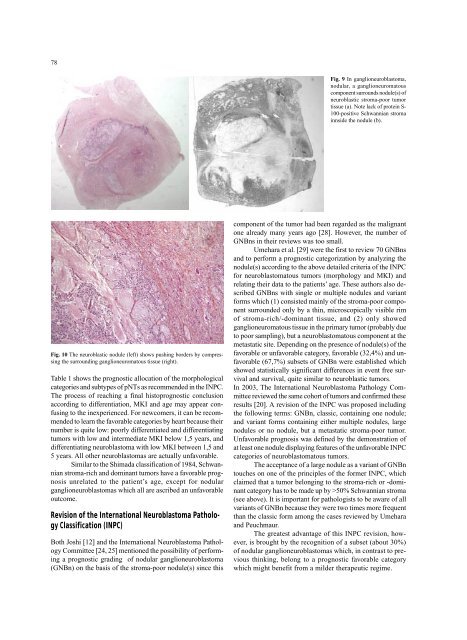Annals of Diagnostic Paediatric Pathology
Annals of Diagnostic Paediatric Pathology
Annals of Diagnostic Paediatric Pathology
You also want an ePaper? Increase the reach of your titles
YUMPU automatically turns print PDFs into web optimized ePapers that Google loves.
78<br />
Fig. 9 In ganglioneuroblastoma,<br />
nodular, a ganglioneuromatous<br />
component surrounds nodule(s) <strong>of</strong><br />
neuroblastic stroma-poor tumor<br />
tissue (a). Note lack <strong>of</strong> protein S-<br />
100-positive Schwannian stroma<br />
innside the nodule (b).<br />
Fig. 10 The neuroblastic nodule (left) shows pushing borders by compressing<br />
the surrounding ganglioneuromatous tissue (right).<br />
Table 1 shows the prognostic allocation <strong>of</strong> the morphological<br />
categories and subtypes <strong>of</strong> pNTs as recommended in the INPC.<br />
The process <strong>of</strong> reaching a final histoprognostic conclusion<br />
according to differentiation, MKI and age may appear confusing<br />
to the inexperienced. For newcomers, it can be recommended<br />
to learn the favorable categories by heart because their<br />
number is quite low: poorly differentiated and differentiating<br />
tumors with low and intermediate MKI below 1,5 years, and<br />
differentiating neuroblastoma with low MKI between 1,5 and<br />
5 years. All other neuroblastomas are actually unfavorable.<br />
Similar to the Shimada classification <strong>of</strong> 1984, Schwannian<br />
stroma-rich and dominant tumors have a favorable prognosis<br />
unrelated to the patient’s age, except for nodular<br />
ganglioneuroblastomas which all are ascribed an unfavorable<br />
outcome.<br />
Revision <strong>of</strong> the International Neuroblastoma <strong>Pathology</strong><br />
Classification (INPC)<br />
Both Joshi [12] and the International Neuroblastoma <strong>Pathology</strong><br />
Committee [24, 25] mentioned the possibility <strong>of</strong> performing<br />
a prognostic grading <strong>of</strong> nodular ganglioneuroblastoma<br />
(GNBn) on the basis <strong>of</strong> the stroma-poor nodule(s) since this<br />
component <strong>of</strong> the tumor had been regarded as the malignant<br />
one already many years ago [28]. However, the number <strong>of</strong><br />
GNBns in their reviews was too small.<br />
Umehara et al. [29] were the first to review 70 GNBns<br />
and to perform a prognostic categorization by analyzing the<br />
nodule(s) according to the above detailed criteria <strong>of</strong> the INPC<br />
for neuroblastomatous tumors (morphology and MKI) and<br />
relating their data to the patients’ age. These authors also described<br />
GNBns with single or multiple nodules and variant<br />
forms which (1) consisted mainly <strong>of</strong> the stroma-poor component<br />
surrounded only by a thin, microscopically visible rim<br />
<strong>of</strong> stroma-rich/-dominant tissue, and (2) only showed<br />
ganglioneuromatous tissue in the primary tumor (probably due<br />
to poor sampling), but a neuroblastomatous component at the<br />
metastatic site. Depending on the presence <strong>of</strong> nodule(s) <strong>of</strong> the<br />
favorable or unfavorable category, favorable (32,4%) and unfavorable<br />
(67,7%) subsets <strong>of</strong> GNBn were established which<br />
showed statistically significant differences in event free survival<br />
and survival, quite similar to neuroblastic tumors.<br />
In 2003, The International Neuroblastoma <strong>Pathology</strong> Committee<br />
reviewed the same cohort <strong>of</strong> tumors and confirmed these<br />
results [20]. A revision <strong>of</strong> the INPC was proposed including<br />
the following terms: GNBn, classic, containing one nodule;<br />
and variant forms containing either multiple nodules, large<br />
nodules or no nodule, but a metastatic stroma-poor tumor.<br />
Unfavorable prognosis was defined by the demonstration <strong>of</strong><br />
at least one nodule displaying features <strong>of</strong> the unfavorable INPC<br />
categories <strong>of</strong> neuroblastomatous tumors.<br />
The acceptance <strong>of</strong> a large nodule as a variant <strong>of</strong> GNBn<br />
touches on one <strong>of</strong> the principles <strong>of</strong> the former INPC, which<br />
claimed that a tumor belonging to the stroma-rich or -dominant<br />
category has to be made up by >50% Schwannian stroma<br />
(see above). It is important for pathologists to be aware <strong>of</strong> all<br />
variants <strong>of</strong> GNBn because they were two times more frequent<br />
than the classic form among the cases reviewed by Umehara<br />
and Peuchmaur.<br />
The greatest advantage <strong>of</strong> this INPC revision, however,<br />
is brought by the recognition <strong>of</strong> a subset (about 30%)<br />
<strong>of</strong> nodular ganglioneuroblastomas which, in contrast to previous<br />
thinking, belong to a prognostic favorable category<br />
which might benefit from a milder therapeutic regime.
















